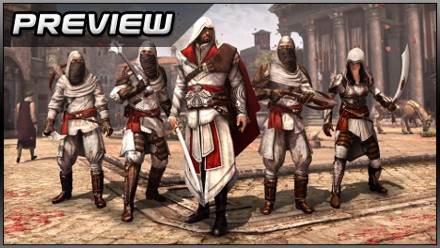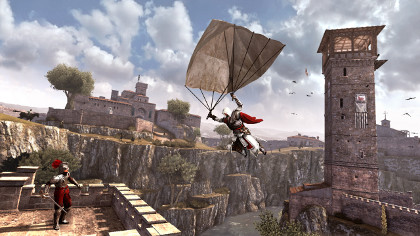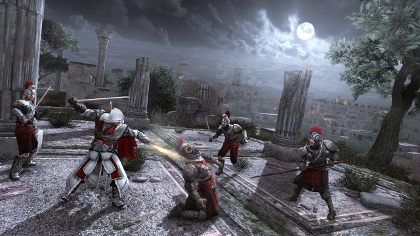
I could have started this Assassin’s Creed: Brotherhood preview 45 minutes ago, were it not for the council road-sweeper merrily whirring and beeping up and down below the window. Or the fair-haired toddler screaming randomly in the garden opposite. Or the bastard in the “office” downstairs listening to Kanye West at bone-dislocating volume.
Were I inside a game of Brotherhood right now (and given the franchise’s hunger for faithfully recreated settings and eras, a London-based instalment doesn’t seem entirely unlikely), I would have to Take Steps. Down the stairs and into the street, to whit, where I’d sidle in amongst the city-slickers at the bus stop. I’d let a few seconds pass, then chop the air absently, as though scooping a strand of hair out of my face – and implacable killers would pop into being on surrounding rooftops and descend, like so many Swords of Damocles, on each and every source of distraction.
It’d be over in seconds – the faintest tinkle of breaking glass, a few punctured gasps, blissful silence. I wouldn’t even bother to watch. I’d just stroll back to my door, safe in the knowledge that followers of the Creed leave no trails of evidence, disintegrating into thin air after completing their lethal work. Then I’d sit down and finally be able to get on with my – well, it appears that I already have. Lucky break for you, Mr Kanye West Fan.
Player-directed NPC assassins are, of course, Brotherhood’s major new single player feature. They’re more like sharply tailored homing missiles than allies per se. A maximum of twelve are available for disposal at once, appearing as red bars beneath your synch (health) gauge in top left.
To cash in those bars for streaks of cold, hooded vengeance, simply tag whoever needs bumping off with left trigger and squeeze right bumper. Whole groups of cheerfully oblivious blood-bags can be roped into the fun by keeping the trigger held and twitching left analog stick, the number of sharp points you have trained on each man displayed as red dots beside the lock-on bracket.
The obvious comparison is Splinter Cell: Conviction‘s controversial Mark & Execute ability, whereby furrowed terrorist foreheads could be queued up and perforated in a blaze of automated fire, but the checks and balances are a damn sight weightier than a depleted energy bar. Assassins can die, see. The initial strike never seems to miss, but with the element of surprise lost your disciples will be vulnerable to counter-attack. Best avert your eyes and quit the hotzone, then, giving the exposed Creedsters an opportunity to de-expose themselves before guardsmen arrive. They won’t evaporate in full view, because that would leave the most dreadful unsightly holes in Assassin’s Creed’s already rocky sense of realism. They’re a bit like Invisible Boy from Mystery Men, basically. Just handier with a dagger.
They’re also off-limits till you’re a few hours in. Assassin’s Creed 2 liked a bit of semi-playable preamble, and despite beginning in media res Brotherhood is almost as methodical in design. It’s just as accessible too, with a laughably simple premise that absolutely doesn’t require a thorough grounding in conspiracy politics and quantum mechanics.
The action picks up where the previous game left off, with hot shot Renaissance assassin Ezio Auditore standing in a secret part of the Vatican, having wrested a pre-human artefact from the hands of the avaricious Templars, chewing the fat with some kind of astral projection, who’s actually talking to Ezio’s distant descendent Desmond, who’s listening in on the conversation via the memories embedded in his genetic code, holographically re-enacted by the wondrous Animus machine, in order to glean the locations of mystic temples in the present. Got all that? I didn’t think so. David Cage, eat your heart out.

Leonardo da Vinci has put together a few new gadgets for Ezio to play with, like this glider thing. Beware - not all of them are in friendly hands.
Suffice to say gruff old uncle Mario shows up and the two men elope to the Auditore villa in Monteriggioni, where Ezio gets propositioned by women a lot, tries his hand at wielding a cannon, rescues a horse and has a bust-up with political genius and fellow assassin Niccolò Machiavelli. All of which helpfully enables you to brush up on your parkour, trotting across the township’s terracotta rooftops and taking in the sunset from its towers.
Before long however Monteriggioni is besieged by the Borgia family, Templar figureheads to a sneering, simpering man. His morning cuddles interrupted by cannon ball, Ezio dutifully nips over to the walls (cue a rather thrilling horse-riding sequence) and puts those fledgling artillery skills to good use, picking and popping enemy batteries, but all is lost when the invaders breach the front gate, gun down Mario and seriously injure the young assassin himself. Did I say all is lost? I meant apart from the bit where the surviving Auditores high-tail it down a hidden passageway. Having seen his mother and sister to safety, Ezio sets off for Rome and vengeance.
Several hundred years later, VR voyager Desmond and his band of groovy young hipster hackers are on the run from Abstergo, the modern-day corporate manifestation of the Templar conspiracy, and where should their travels take them but to the ruins of the Auditore mansion. Smart move as it transpires, because Desmond’s frequent trips into the computer-generated past have left imprints on his psyche, enabling him to trace his ancestor’s movements in the present.






 Satoru Iwata Video Interview - the late Nintendo president spoke with Kikizo in 2004 as 'Nintendo Revolution' loomed.
Satoru Iwata Video Interview - the late Nintendo president spoke with Kikizo in 2004 as 'Nintendo Revolution' loomed. Kaz Hirai Video Interview - the first of Kikizo's interviews with the man who went on to become global head of Sony.
Kaz Hirai Video Interview - the first of Kikizo's interviews with the man who went on to become global head of Sony. Ed Fries Video Interview - one of Xbox's founders discusses an epic journey from Excel to Xbox.
Ed Fries Video Interview - one of Xbox's founders discusses an epic journey from Excel to Xbox. Yu Suzuki, the Kikizo Interview - we spend time with one of gaming's most revered creators.
Yu Suzuki, the Kikizo Interview - we spend time with one of gaming's most revered creators. Tetris - The Making of an Icon: Alexey Pajitnov and Henk Rogers reveal the fascinating story behind Tetris
Tetris - The Making of an Icon: Alexey Pajitnov and Henk Rogers reveal the fascinating story behind Tetris Rare founders, Chris and Tim Stamper - their only interview? Genuinely 'rare' sit down with founders of the legendary studio.
Rare founders, Chris and Tim Stamper - their only interview? Genuinely 'rare' sit down with founders of the legendary studio. The History of First-Person Shooters - a retrospective, from Maze War to Modern Warfare
The History of First-Person Shooters - a retrospective, from Maze War to Modern Warfare